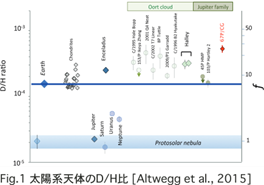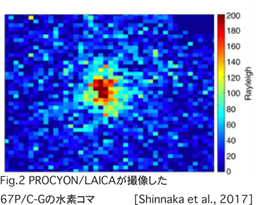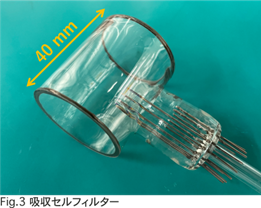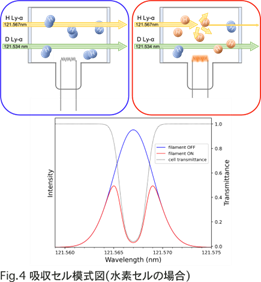Yamazaki, Ashita
Department of Earth and Planetary Science
Graduate School of Science, The University of Tokyo
1st year Ph.D student in Yoshioka Laboratory
Email: ayamazaki0309 at g.ecc.u-tokyo.ac.jp
Room: 4E1, Transdisciplinary Sciences Building (Kashiwa Campus)
Research Theme
Development of Optical Filters for Isotopic Measurements of Hydrogen Coronae
Significance of D/H observations
The isotopic abundance ratio of hydrogen (D/H ratio) is a crucial factor in uncovering the origin and evolution of planetary bodies. For instance, it is known that the D/H ratio of water is higher in objects that formed in the outer regions of the protoplanetary disk [Horner et al., 2007]. Figure 1 displays the measured D/H ratio of planetary bodies, showing a noticeable trend.

Hydrogen Coronae
Hydrogen coronae are phenomena that reflect the D/H ratio of planetary bodies. The atomic hydrogen atmosphere emits light through resonant scattering of solar radiation, particularly at the Hydrogen Lyman alpha line. Figure 2 presents an image of the hydrogen coma of comet 67P/C-G captured at this wavelength of light. These observations can provide not only the D/H ratio but also information on atmospheric hydrogen temperature and spatial structure, offering valuable insights into the processes of atmospheric generation and escape.

Absorption Cell Filters
Absorption cell filters have been developed as a means to remotely quantify the D/H ratio and hydrogen temperature of hydrogen coronae. In the case of the Hydrogen Absorption Cell Filter, it absorbs the H Ly-α line emitted by hydrogen atoms through resonant scattering. It consists of a cylindrical glass cell with both sides made of MgF2, filled with hydrogen gas. When tungsten filaments within the cell are activated, the hydrogen gas thermally dissociates into atoms, which resonantly scatter H Ly-α that enters the cell, resulting in the absorption of H Ly-α in the line of sight. Since there is a 33 pm difference in wavelengths between H and D Ly-α, H and D cells absorb these emissions respectively, enabling separate measurements of hydrogen and deuterium densities in the corona. Due to its small size, lightweight design, and low power consumption, it is well-suited for mounting on ultra-small spacecraft.


Main issues of the filter
While this filter appears to be ideal for Ly-α observations, two main issues persist: 1) oxidation of tungsten filaments due to contamination by H2O and O2, and 2) deterioration of D cell measurement accuracy due to contamination by H2.
Measures
To address these issues, I plan to use a Palladium filter, known for selectively permeating H2/D2 gas, to ensure that pure H2/D2 gas is filled in the cell as a solution to issue 1). Additionally, Zr and Ti, known as getter materials that adsorb active gasses, will be used to remove H2 gas from the vacuum line before enclosing D2 gas as a preventive measure against issue 2). I am currently conducting quantitative evaluations of these measures to ensure stable and precise measurements using Absorption Cell Filters.
Progress and future work
So far, I have quantitatively demonstrated the validity of using Palladium filters for selectively permeating H2/D2 gas and conducted a durability test of the filaments using an actual cell manufactured using this method. Moving forward, I will perform a quantitative analysis of the getter material and evaluate the effects of H2 gas mixing into the D cell through absorption profile measurements. As complete prevention of this contamination may not be feasible, a calibration method for deriving D/H ratios will also need to be established.
Research Achievements
A. Yamazaki, K. Goda, T. Matsumoto, S. Teramoto, K. Yoshioka. Transmission Characteristics of an Optical Filter for UV Observations. UVSOR activity report. 2023.
Taguchi, M. Kuwabara, T. Katsumata, M. Tateyama, K. Yoshioka, Y. Suzuki, K. Goda, K. Inoue, A. Tomioka, A. Yamazaki. Evaluation of Absorption Stability of a Hydrogen Absorption Cell. UVSOR activity report. 2022.
Suzuki, M. Kuwabara, M. Taguchi, K. Yoshioka, T. Katsumata, M.Tateyama, K. Goda, A. Yamazaki, K. Inoue, A. Tomioka. Performance Evaluation of UV Absorption Filter onboard Spacecraft. UVSOR activity report. 2022.
○A. Yamazaki, K. Goda, Y. Suzuki, M. Taguchi, M. Kuwabara, K. Yoshioka. Specifications and development of Hydrogen Imager for Comet Interceptor mission. JpGU 2022. Makuhari, Japan. May 23, 2022.
○K. Goda, A. Yamazaki, Y. Suzuki, K. Yoshioka, K. Enya, S. Sugita. Removal of stray light generated by bandpass filters in visible light optics and focusing performance of optical systems. JpGU 2022. Makuhari, Japan. May 23, 2022.
